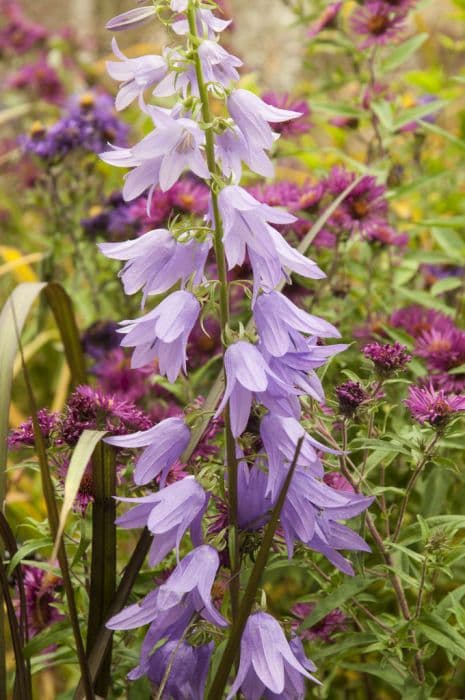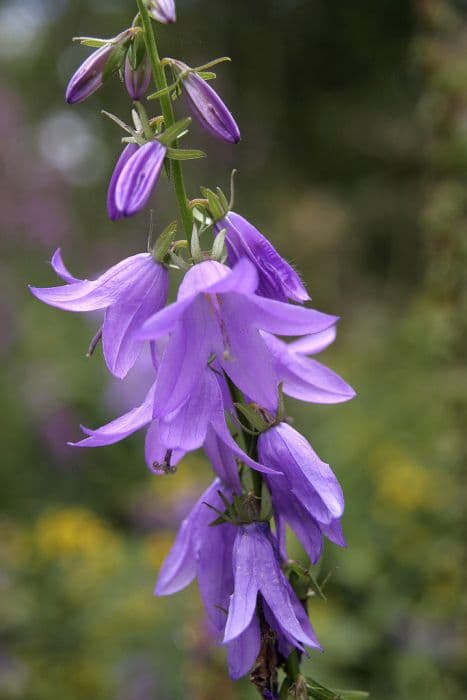Peach-leaved bellflower Campanula persicifolia 'Gawen'

ABOUT
The plant known as 'Gawen', a variety of peach-leaved bellflower, boasts a striking and graceful appearance. Its foliage consists of elongated, lance-shaped leaves that present a lush, green backdrop. Come blooming season, this perennial bursts into a splendid display of delicate flowers. These flowers resemble little bells or inverted cups and are typically a soft shade of blue, adding a touch of cool serenity to the garden palette. They are arranged on tall, slender stems and form an impressive visual as they sway gently in the breeze, attracting both admiration from onlookers and pollinators such as bees and butterflies. The pleasing contrast between the foliage and these sky-hued blooms makes the 'Gawen' a popular choice for ornamental purposes in garden beds and borders. Its overall form is upright and clumping, making it a neat addition to any outdoor space desiring a touch of natural elegance.
About this plant
 Names
NamesFamily
Campanulaceae.
Synonyms
Peach-Leaved Bellflower, Willow Bell, Fairy Bellflower, Bluebell.
Common names
Campanula persicifolia 'Gawen'.
 Toxicity
ToxicityTo humans
Campanula persicifolia, commonly known as Peach-leaved Bellflower, is not considered toxic to humans. As such, ingestion of this plant is not typically associated with poisoning or adverse health effects. However, it is always advisable to avoid eating plants not explicitly grown for consumption, as individual sensitivities or allergies could cause unexpected reactions.
To pets
Peach-leaved Bellflower is generally considered non-toxic to pets as well. Ingestion of this plant should not cause poisoning; however, as with any non-food plant, consumption could potentially result in mild gastrointestinal upset due to the animal's individual sensitivity or if consumed in large quantities. It’s wise to monitor pets who have a habit of chewing on plants and consult with a veterinarian if any concerning symptoms arise.
 Characteristics
CharacteristicsLife cycle
Perennials
Foliage type
Deciduous
Color of leaves
Green
Flower color
White
Height
2-3 feet (60-90 cm)
Spread
1-1.5 feet (30-45 cm)
Plant type
Herb
Hardiness zones
3-8
Native area
Europe
Benefits
 General Benefits
General Benefits- Attracts pollinators: The bell-shaped flowers of the Peach-leaved Bellflower attract bees and butterflies, which are essential for pollination in the garden.
- Decorative appeal: With its delicate blue to violet flowers, the plant adds aesthetic value and beauty to gardens and floral arrangements.
- Low maintenance: Once established, it is drought-tolerant and requires minimal care, making it ideal for busy gardeners or those with less experience.
- Cold hardy: It can withstand colder climates, adding color and life to gardens in a wide range of temperature zones.
- Long blooming season: The flowering period extends through summer, providing a long-lasting display of blooms.
- Versatile use: Suitable for borders, rock gardens, and cottage gardens, its versatility makes it a valuable addition to many landscape designs.
- Wildlife habitat: Provides shelter and nectar for beneficial insects, contributing to biodiversity in the garden ecosystem.
- Good for cutting: The flowers hold up well in vases, making them excellent for cut flower arrangements.
- Easy to propagate: The plant can be easily propagated by seed or division, allowing gardeners to increase their stock or share with others.
- Resilient to pests: Generally resistant to many pests, reducing the need for chemical treatments.
 Medical Properties
Medical PropertiesThis plant is not used for medical purposes.
 Air-purifying Qualities
Air-purifying QualitiesThis plant is not specifically known for air purifying qualities.
 Other Uses
Other Uses- Peach-leaved bellflower's dried seed pods can be used in decorative arrangements, providing a rustic aesthetic to floral crafts or dried bouquets.
- The robust stems and foliage can be part of a green roof planting scheme, as its hardy characteristics allow it to thrive in well-drained substrate with minimal care.
- The plant's nectar-rich flowers can be a food source for beneficial garden insects, contributing to biological pest control by attracting predatory insects.
- Cultivated specimens of peach-leaved bellflower can be used in educational settings to demonstrate plant growth cycles, pollination, and seed dispersal to students.
- The plant can be incorporated into landscape designs intended for viewing under moonlight, the white flowers reflect moonlight and create nighttime visual interest.
- As a non-toxic plant, peach-leaved bellflower can be safely planted in outdoor pet enclosures, adding diversity without the risk of pet poisoning.
- Can be used as a natural dye source, where its flowers may yield subtle color variations for fabrics or crafting materials when prepared correctly.
- Used in a sensory garden, the plant’s flowers and foliage provide a variety of textures and scents to stimulate the senses.
- The flower's ability to self-seed and spread can be utilized for erosion control in suitable climates, helping to stabilize soil on slopes.
- Their tall, slender growth habit makes them suitable as "living mulch" when planted densely, suppressing weeds and retaining soil moisture.
Interesting Facts
 Feng Shui
Feng ShuiThe Peach-leaved Bellflower is not used in Feng Shui practice.
 Zodiac Sign Compitability
Zodiac Sign CompitabilityThe Peach-leaved Bellflower is not used in astrology practice.
 Plant Symbolism
Plant Symbolism- Gratitude: Campanula, commonly known as Bellflower, often symbolizes gratitude due to its delightful bell shape, which resembles giving or receiving a gift.
- Constancy and Perseverance: The Bellflower, with its ability to grow in difficult conditions and return year after year, represents persistence and the constant nature of love.
- Humility: Its bell-shaped blooms that hang down suggest an air of humility, often drawing a comparison with people who have a modest but strong character.
- Hope: The Bellflower has been associated with hope, its growth habit and the way it regrows and blooms every year instills a sense of optimism and belief in a better future.
 Water
WaterFor the Peach-leaved Bellflower, it's essential to maintain moist but not waterlogged soil, especially during its active growing season in spring and early summer. Water the plant thoroughly once the top inch of soil feels dry, which might be approximately once a week in moderate climates. Depending on weather conditions and soil drainage, this may require about 1 to 1.5 gallons for an established plant in ground. Potted specimens may need a more frequent watering schedule. It's best to water early in the morning at soil level to prevent leaf wetness and reduce the risk of disease.
 Light
LightPeach-leaved Bellflower thrives in conditions where it can receive full sun to partial shade. The best spot for this plant would allow for at least 6 hours of sunlight, although a bit of afternoon shade is beneficial in hotter climates to prevent scorching. When planted in an area that's too shaded, the plant may grow leggy and produce fewer flowers.
 Temperature
TemperaturePeach-leaved Bellflower is cold-hardy and can withstand temperatures down to about 20°F without significant damage, making it suitable for gardeners in USDA zones 3 through 8. The ideal temperature range for this plant is between 60°F to 75°F during the growing season. While it can survive temporary spikes above this range, persistent high heat may stress the plant.
 Pruning
PruningPruning Peach-leaved Bellflower is mainly done to promote a second flush of flowers and maintain a tidy appearance. Immediately after the first bloom, cut back the flowering stems to just above a set of leaves or a node. This can be done usually in midsummer, encouraging the plant to rebloom. Deadheading spent flowers regularly will also keep the plant looking neat and may extend the blooming period.
 Cleaning
CleaningAs needed
 Soil
SoilPeach-leaved bellflower thrives in a well-draining soil mix composed of loam, peat or compost, and sharp sand or perlite to enhance drainage. It prefers a soil pH range of 6.0 to 8.0 for optimal growth, with a slightly alkaline condition being ideal.
 Repotting
RepottingPeach-leaved bellflower generally doesn't need frequent repotting and can be repotted every 2-3 years or when it becomes root-bound. Repotting should be done in the spring before the onset of the growing season.
 Humidity & Misting
Humidity & MistingPeach-leaved bellflower does not have high humidity requirements and can tolerate the typical humidity levels found outdoors. It is relatively adaptable to various humidity conditions, making it versatile in different garden settings.
 Suitable locations
Suitable locationsIndoor
Use well-lit spot, loamy soil, moderate watering.
Outdoor
Plant in sun or part-shade, in well-draining soil.
Hardiness zone
3-8 USDA
 Life cycle
Life cycleCampanula persicifolia 'Gawen', commonly known as Peach-leaved Bellflower, starts its life as a seed that germinates in cool temperatures, typically in early spring. After germination, the seedling develops into a rosette of foliage, growing its characteristic long, narrow leaves. Over the course of the first season, the plant establishes a strong taproot and vegetative growth. In its second year and subsequent years, it sends up flowering stalks in late spring to early summer, adorned with bell-shaped flowers that range from white to soft blue shades. Following pollination, often by bees, the flowers produce small capsule-like fruits containing seeds, which, when mature, are dispersed to start new plants. In winter, the plant may die back, especially in colder climates, but the root system remains alive and it re-emerges in spring.
 Propogation
PropogationPropogation time
Spring-Early Summer
The most popular method to propagate Campanula persicifolia 'Gawen', commonly known as Peach-leaved Bellflower, is by division. The best time for dividing this perennial plant is either in early spring or after it has finished blooming in late summer or early fall. To propagate by division, gently uplift the clump of the plant with a garden fork, being careful not to damage the root system. Shake off excess soil and identify natural divisions or clumps that can be separated. Using your hands or a sharp knife, divide the clump into smaller sections, ensuring each has a portion of roots attached. Replant the divisions immediately, watering them well to help them establish. This method is especially effective due to the plant's clump-forming habit, and divisions can start to thrive quickly, leading to a fuller garden or allowing for the sharing of plants with friends and other gardeners.








